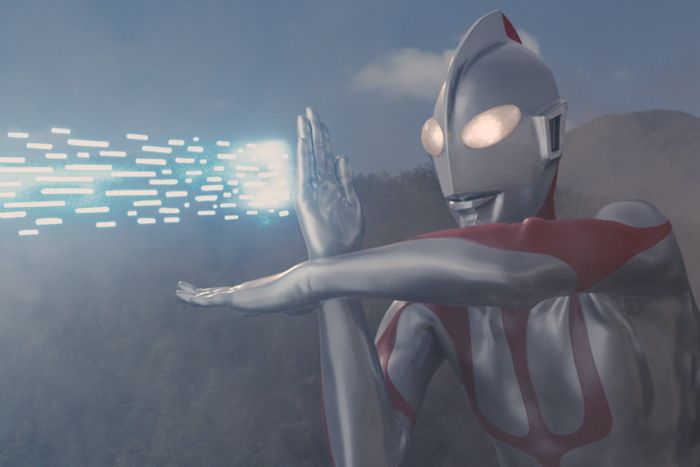
The Japanese superhero-versus-space-aliens flick Shin Ultraman not only looks different — some might even say better — than any recent American monster or superhero movie, it also moves and sounds unlike anything in Stateside multiplexes right now. Director Shinji Higuchi and writer Hideaki Anno’s modernized reboot of the ’60s TV action series strikes just the right balance between adult-oriented science-fiction and campy, kid-friendly tokusatsu (“special effects”) adventure. With tense monster battles and inspired kaiju cameos, it’s a perfect summer movie for both diehard Ultraman fans and uninitiated viewers.
Shin Ultraman (which premieres in the U.S. this Saturday at the New York Asian Film Festival) is the second installment of a planned tokusatsu movie trilogy that started with 2016’s Shin Godzilla and will conclude eventually with Shin Kamen Rider. In their latest collaboration, Higuchi — director of both the 2015 live-action Attack on Titan movies — and Anno (creator of the influential Neon Genesis Evangelion anime series) reintroduce Ultraman (Bin Furuya) as one of several extraterrestrials that have recently appeared across modern-day Japan. Once Ultraman bonds with good-hearted government man Shinji Kaminaga (Takumi Saitoh), the Japanese government and other giant monsters begin hounding down the psychically-linked duo. To his enemies, Ultraman is a valuable weapon, but to the people, Ultraman is a selfless hero.
Some American monster-movie buffs have been anticipating whatever Higuchi and Anno did next since 2016, when Shin Godzilla reminded fans what a smart and modern kaiju film looks like. In both movies, Higuchi uses rhythmic, fast-paced editing and handheld photography to capture the spur-of-the-moment chaos of humanity’s first contact with Ultraman. Shin Ultraman’s dynamic old-school battles also focus, blessedly, on choreography and creature design instead of shifting camera perspectives and computer-generated collateral damage. It’s a film about how its characters see the world, more so than their situational peril.
What kind of feedback did you and Hideaki Anno get from Toho after Shin Godzilla and how did it affect the way you planned Shin Ultraman?
Actually, some Toho people are here in the room with me. So I’m feeling some pressure not to talk about Toho. [Laughs.] Rather than concern ourselves with studio feedback, Anno and I really focused on audience feedback. What would a big audience want from an Ultraman movie? Ultraman originally premiered in the mid-1960s as a 30-minute TV series, about ten years after Godzilla. The challenge for us was how do you turn a half-hour TV show into a feature film?
What did Ultraman mean to you as a kid and how did its impact on you inform your take on the character?
When I was a kid, I saw Ultra Q and Ultraman when they originally aired on TV. Those shows stunned me and kind of messed up my life, until I became an adult. To the kids of today, Ultraman is from the distant past — 50 years ago! But to my generation, Ultraman represents the future. The original series was an aspirational fantasy: society will be like this when I grow up. With Shin Ultraman, we tried to give young viewers the same thrills and surprises that we got from the original show as kids.
Both Shin Ultraman and Shin Godzilla seem optimistic and light-hearted when compared to the apocalyptic American MonsterVerse movies, like Godzilla: King of the Monsters and Godzilla vs. Kong. I know you’re a fan of Gareth Edwards’s 2014 Godzilla movie, but did the American MonsterVerse movies come up in discussions while making Shin Ultraman?
We immediately ran into a practical problem: We didn’t have as big a budget as those American MonsterVerse films, so we couldn’t really destroy the world like they did. We tried to compensate by coming up with a uniquely appealing screenplay and really interesting characters.
Shin Godzilla brought to mind then-recent national disasters: the 2011 Tohoku earthquake and the Fukushima nuclear meltdown. Would you say that Shin Ultraman was also made with a focus on Japanese current events or politics?
We weren’t trying to reflect specifically Japanese concerns when we made Shin Ultraman. As with Shin Godzilla, we tried to use monsters to reflect the social problems of the time. In both cases, we were concerned with what would happen to regular people if Godzilla or Ultraman were real. The Fukushima meltdown and the Tohoku earthquake are the sort of natural disasters that we haven’t seen in several hundred years. In a way, those disasters are the kaiju of our day.
Some interpreted the way Shin Godzilla’s mild-mannered protagonist Yaguchi cuts through bureaucratic red tape and upsets the Americans’ plans to stop Godzilla as an endorsement of Japanese jingoism and nationalism. Would you say that Shin Ultraman reflects or extends Shin Godzilla’s politics?
We didn’t base Shin Godzilla’s characters on real people. Actually, it was more like wish fulfillment: I wish there were people like Yaguchi. For Shin Ultraman, we started from the assumption that the previous movie’s problems were already solved, so we tried not to rehash the same issues.
I’ve read that you and Hideaki Anno were particularly inspired by an original 1983 painting by Ultraman creator Toru Narita, called Incarnation of Truth, Justice, and Beauty. Can you talk a little about that painting and its influence on your character design?
In interviews, Narita spoke about the little light on Ultraman’s chest, the one that signals, when it flashes red, that he’s run out of energy. Narita never really wanted to use that light in Ultraman’s design. He wanted a more streamlined look, like in his painting. So Anno and I wanted to reflect Narita’s original desires.
The fast-paced editing in both Shin Ultraman and Shin Godzilla give these movies a very modern feel. How did you negotiate the look and pace of these movies?
When we shot them, we filmed with the idea that the finished product would come together as we edited it. We shot tons and tons of footage. Maybe I should call it “raw material,” since we knew that a lot of it was not going to make it into the finished film. But we made sure that our actors had nailed down their lines and that their delivery was exactly what we wanted, because if we had little variations, we’d have even more takes to select from. So we made sure that the tone and structure of our film was established among the cast and crew.
The theme music from Ultra Q, the first Ultraman series, plays during the film’s monster battles, suggesting you wanted to give Shin Ultraman a semi-classic feeling. How did you want the music of the movie to reflect your take on the character?
You can’t beat the impact of watching Ultraman and Ultra Q back when those shows originally aired. We didn’t have so much confidence that we thought we were going to make something better than those shows. So when it came to selecting music, we felt like featuring music from the original shows was only appropriate. On the other hand, it wouldn’t have been a very modern movie if we had only used music from those older shows. And as the story progresses, the original series’ music also sounds more modern and updated.
You used what looks like motion-capture technology for Shin Ultraman. Anno was also one of the models for Ultraman’s physical movements. Why didn’t you try on the Ultraman suit, too?
[Laughs.] As you can see, I’m far from Ultraman’s physical type. There was some talk about me playing a monster, but no one wanted me to. Bin Furuya, the original actor who played Ultraman, has this amazing physique. Japanese people tend to be short with big heads and short legs, and while I may not be the right physique to play Ultraman, Furuya is. He’s very tall with long thin arms and a small head (as compared to the rest of his body). Not very Japanese … maybe not very human. So, really, perfect for playing Ultraman.
Lots of people have played Ultraman and his siblings since then, but they haven’t had Furuya’s proportions, so we wanted him to play the character. And he did, since he’s still around. We first took his physique and turned it into 3D data. Then we had him move like Ultraman, which we recorded using motion-capture technology. We also recorded Anno’s movements since he played Ultraman back in the day in an amateur film. “I wanna play him, too,” he said. It’s very brave to do that kind of motion-capture performance, because you have to wear a very tight full-bodysuit. But Anno did it.
I love that there’s a Larugeus cameo in an early Shin Ultraman scene. If you had to recommend an episode or three of either Ultra Q or the original Ultraman series — or maybe just tell us some of your favorite kaiju — which would you recommend?
Harunosuke Nakagawa directed “I Saw a Bird,” the episode with Larugeus, and two other Ultra Q episodes. All three are great. As for my favorite kaiju: I really like Kanegon, a little boy who transforms into a kaiju. I want to use him in a film.




